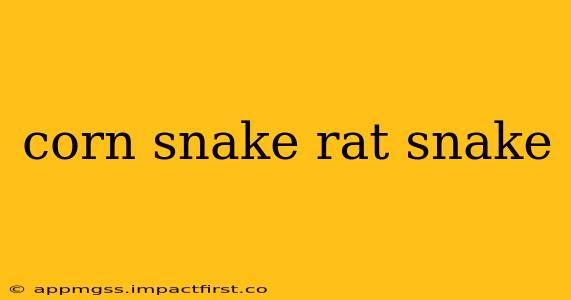Corn snakes and rat snakes are both popular choices among reptile enthusiasts, often admired for their docile temperaments and relatively easy care. However, despite their shared colubrid family and similar appearances, there are key distinctions between these two species. This comprehensive guide will delve into the differences, helping you understand which snake might be the better fit for you.
What are the Key Differences Between Corn Snakes and Rat Snakes?
The most significant differences between corn snakes and rat snakes lie in their appearance, geographic location, and size. While some rat snake subspecies closely resemble corn snakes, careful observation will reveal distinct characteristics.
Appearance: Spotting the Subtle (and Not-So-Subtle) Differences
Corn Snakes (Pantherophis guttatus): Generally smaller than rat snakes, corn snakes are known for their striking patterns. Their coloration varies widely, ranging from reds, oranges, and yellows to browns and blacks, often exhibiting a characteristic "checkerboard" or "rattlesnake" pattern. However, many morphs (color variations bred in captivity) exist, boasting unique patterns and colors. Their scales are relatively smooth.
Rat Snakes (Pantherophis spp.): This is a broad category encompassing many subspecies. Rat snakes display a greater diversity in size and coloration than corn snakes. Some subspecies have a blotchy pattern, while others exhibit stripes or a more uniform color. Some rat snake subspecies can grow significantly larger than corn snakes. Their scales can feel slightly rougher to the touch than those of a corn snake.
Size: A Matter of Scale
Corn Snakes: Typically reach lengths between 3 and 5 feet, although larger specimens can be found.
Rat Snakes: Rat snakes exhibit a broader size range depending on the subspecies. Some species remain relatively small, while others can reach lengths exceeding 6 feet.
Geographic Location: Where They Call Home
Corn Snakes: Native to the southeastern United States, from southern Florida to the eastern portions of Texas and Oklahoma, northward to southern Illinois and up along the Atlantic coast.
Rat Snakes: Rat snakes have a much wider distribution across North America. They are found in various habitats across a vast region, including the eastern and central United States, and parts of Canada and Mexico. Their distribution depends on the specific subspecies.
What is the Temperament Like for Each Species?
Both corn snakes and rat snakes are generally considered docile and easy to handle, making them popular for beginners. However, individual temperaments can vary.
Corn Snakes: Known for their calm demeanor and tolerance of handling. They rarely bite and are generally considered one of the most docile snake species.
Rat Snakes: While most rat snakes are docile, some individuals, particularly larger specimens, might be more reactive or prone to defensive behaviors, such as biting or musk-releasing. Proper handling and gentle socialization are essential.
Which Snake is Easier to Care For?
Both species are relatively low-maintenance, but there are subtle differences:
Corn Snakes: Often considered slightly easier to care for, particularly for beginners. Their smaller size means smaller enclosures, and they have relatively simple dietary requirements.
Rat Snakes: Requiring larger enclosures to accommodate their potential size, rat snakes may also have slightly more specific needs concerning temperature and humidity.
Are Corn Snakes and Rat Snakes Poisonous?
No. Neither corn snakes nor rat snakes are venomous. They are constrictors, killing their prey by squeezing it until it suffocates.
What Do Corn Snakes and Rat Snakes Eat?
Both species are carnivorous, but their prey preferences might differ slightly based on size and availability.
Corn Snakes: Primarily feed on rodents, such as mice and rats, often sized appropriately for the snake's age and size.
Rat Snakes: Also feed on rodents, but their larger size allows them to consume larger prey items, including rats, mice, and occasionally birds or other small animals.
What's the Lifespan of Corn Snakes and Rat Snakes?
Corn Snakes: Have a relatively long lifespan, typically living for 15-20 years with proper care. Some individuals have lived even longer.
Rat Snakes: Similar lifespans to corn snakes, typically living for 15-20 years in captivity, though variations exist depending on the subspecies and care provided.
This detailed comparison should help you understand the key differences between corn snakes and rat snakes, allowing you to make an informed decision about which species best suits your lifestyle and experience level. Remember to always research the specific care requirements for the subspecies you are considering before acquiring any snake.
